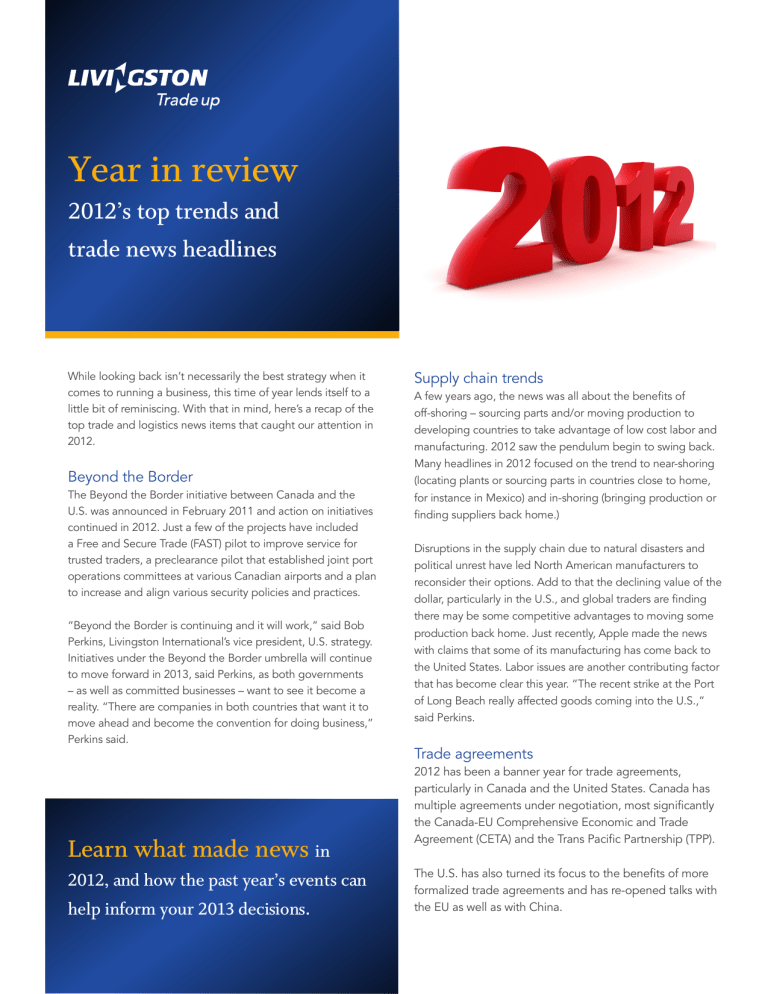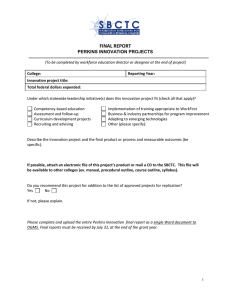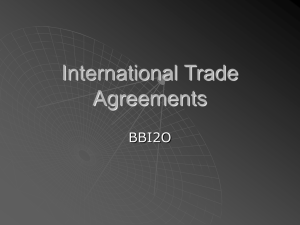Year in review 2012’s top trends and trade news headlines

Year in review
2012’s top trends and trade news headlines
While looking back isn’t necessarily the best strategy when it comes to running a business, this time of year lends itself to a little bit of reminiscing. With that in mind, here’s a recap of the top trade and logistics news items that caught our attention in
2012.
Beyond the Border
The Beyond the Border initiative between Canada and the
U.S. was announced in February 2011 and action on initiatives continued in 2012. Just a few of the projects have included a Free and Secure Trade (FAST) pilot to improve service for trusted traders, a preclearance pilot that established joint port operations committees at various Canadian airports and a plan to increase and align various security policies and practices.
“Beyond the Border is continuing and it will work,” said Bob
Perkins, Livingston International’s vice president, U.S. strategy.
Initiatives under the Beyond the Border umbrella will continue to move forward in 2013, said Perkins, as both governments
– as well as committed businesses – want to see it become a reality. “There are companies in both countries that want it to move ahead and become the convention for doing business,”
Perkins said.
Learn what made news
help inform your 2013 decisions.
in
2012, and how the past year’s events can
Supply chain trends
A few years ago, the news was all about the benefits of off-shoring – sourcing parts and/or moving production to developing countries to take advantage of low cost labor and manufacturing. 2012 saw the pendulum begin to swing back.
Many headlines in 2012 focused on the trend to near-shoring
(locating plants or sourcing parts in countries close to home, for instance in Mexico) and in-shoring (bringing production or finding suppliers back home.)
Disruptions in the supply chain due to natural disasters and political unrest have led North American manufacturers to reconsider their options. Add to that the declining value of the dollar, particularly in the U.S., and global traders are finding there may be some competitive advantages to moving some production back home. Just recently, Apple made the news with claims that some of its manufacturing has come back to the United States. Labor issues are another contributing factor that has become clear this year. “The recent strike at the Port of Long Beach really affected goods coming into the U.S.,” said Perkins.
Trade agreements
2012 has been a banner year for trade agreements, particularly in Canada and the United States. Canada has multiple agreements under negotiation, most significantly the Canada-EU Comprehensive Economic and Trade
Agreement (CETA) and the Trans Pacific Partnership (TPP).
The U.S. has also turned its focus to the benefits of more formalized trade agreements and has re-opened talks with the EU as well as with China.
“There is a definite push to create stronger opportunities for U.S. trade growth,” said Perkins. As the trade flows strengthen and improve, they’ll in turn provide additional opportunities to U.S. businesses.
On the Canadian front, the CETA is in its final stages of negotiation, with hope the deal will be concluded in early
2013. This deal represents an extensive trade agreement for Canada and, according to the government, will present significant opportunities for Canadian companies.
Rising protectionism
While the talk is of more formalized agreements and increasingly integrated economies, tensions among trading nations have escalated in 2012. As a result, there has been an increase in action at the World Trade Organization
(WTO) level, with the WTO taking a more active active role working with countries to find common ground.
Top stories of 2012:
• Beyond the Border
• Supply chain disruption
• Trade agreement growth
• Rising protectionism
• The global economy
2012 was a banner year for trade agreements, particularly in Canada and the U.S.
The mood is due in large part to global economic conditions – when businesses at home are struggling, it’s easy to look beyond borders for a scapegoat. But in the grand scheme of things, despite the fact that there have been high-visibility disputes between China and the U.S. on cars, solar products and rare earths, the affected bilateral trade volume amounts to less than 4 percent*. Global trade requires a delicate balance between protection of national industries and access to foreign markets.
With global trade, the economies of the world have become integrated to the point that when one economy falters, the rest of the world flinches. Make the economy in question a large one and the whole world feels the pinch.
As the largest economy in the world, U.S. economic news and fiscal policy dominated headlines in 2012, which means that the big story for 2013 will likely still be the U.S. economy.
Don’t forget to read our Trends for 2013 outlook!
The global economy
Perhaps the biggest news story, both in trade circles and the general media, was the global economy. 2012 saw
Europe in crisis, the Chinese dragon take a breather,
Canada become a bastion of economic sanity, and the U.S. at the edge of a fiscal cliff. It has been a chaotic year for many nations.
*
Tom Orlik, Wall Street Journal, October 23, 2012
Contact your Livingston account executive e-mail us at solutions@livingstonintl.com
or give us a call at 1-800-837-1063
Visit www.livingstonintl.com
2 Year in review: 2012’s top trends and trade news headlines





